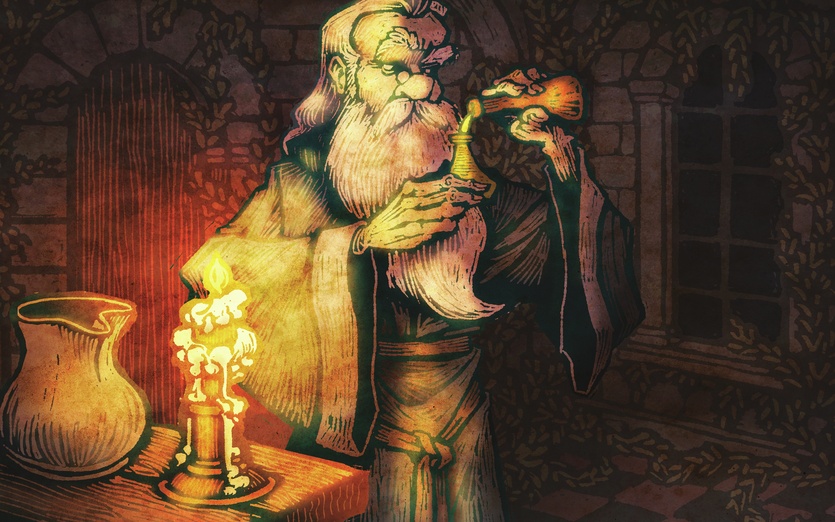A while back I did a very short shout out for the Castle Keepers Guide. I really don't feel like I gave it the attentions it deserves. So I thought I would come back to it and give a further and more in depth overview of this book. (or at least scratch the surface a little deeper.)
The castle keepers guide is the long awaited Game Masters guide for the castles and crusades roleplaying game. Although I myself only got into Castles and crusades a short time before the book came out I could not escape the posts and complaints about how long it took this book to come out. I just wanted to get that out of the way before saying I think this book would be worth the wait, but really should not say it since I was not one of the people who had to wait for it.
The book is a pretty massive tomb, covering a lot of ground. The only GM guide I feel has tried to cover this much in one volume was the 1E AD&D Game masters guide. And at the end of the day I think the CKG just might cover more.
The best way for me to prove this theory of mine is to give you a chapter by chapter and section by section breakdown of the CKG. Give you some idea of exactly how much gaming goodness is in this book.
The book starts off with 8 pages that include table of contents, acknowledgments, and introduction.
PART 1: The Characters.
Chapter 1: Expanding characters.
>>Starts right off with attributes, both alternate ways to generate them and alternate modifiers for them.
>>Adding a seventh attribute, Beauty.
>>Extended class levels, This includes rules for leveling characters up to levl24.
>>Expanding races, From vital info, to the under the hood of race creation and variants.
Chapter 2: Magic.
>>This first section focuses on tools of the trade, Spellbooks and components needed for casting.
>>>This includes price lists and tables for determining number of spells found in a tomb.
>>>Also includes a table of costs for holy symbols.
>>Next is an alternate magic system. Its a spell slot system.
Chapter 3: Expanding equipment.
>>First section is a guide for ropleplaying equipment. As well as price lists for commonly needed items.
>>This next section is a carrying capacity system. With cargo capacity for all kinds of transportation.
>>Contains optional rules for maintaining equipment.
Chapter 4: Non-player Characters.
>>A fairly large section with advice on use of NPCs in your game.
>>Rules for hiring henchmen.
>>Hirelings and loyalty ratings.
Part 2: Worlds of Adventure.
Chapter 5: Worlds of adventure, World.
>>Planning, developing and exploring your game world. This section would surly be invaluable for those creating their own world. Options for picking everything from weather patterns to technology level.
Chapter 6: Worlds of Adventure, City.
>>Economics and urban landscape.
>>Structure and governments.
>>The urban landscape.
>>Culture.
Chapter 7: Worlds of Adventure, Dungeons.
>>Covers landscape and types of underground dwellings.
>>Typical adventures underground.
>>Listen bonuses for monster types.
>>Lists of traps and types of traps.
Chapter 8: Air and Water Adventure.
>>Rules and information on vessels and water based adventures.
Chapter 9: Equipment Wastage.
>>Expands the rules of use, weathering and wastage of equipment in the course of adventures.
>>Effects of different environments of common items.
Chapter 10: Land as Treasure.
>>This chapter is all about using land and titles as reward for your adventures. Titles by class is a great touch in this section.
Chapter 11: Going to War.
>>This is a mass combat section. Rules for squad ratios, Troop types,Movement, and conditions.
>>Rules for moral.
>>Rules for siege on castles and walls.
Chapter 12: Monster Ecology.
>>Monsters concepts.
>>Attributes and ecology of monsters.
>>Monster Alignment.
>>A lot of hints and trips for using monsters in your games.
>>Random monster tables divided by tier.
Chapter 13: Expanding the genera.
>>This section is all about taking your game outside of the medieval or fantasy pigeon hole.
>>Information for running C&C in different settings, Ages and styles.
>>Firearms rules. From black powder to laser pistols.
>>Grenade and rocket rules. Rules for mishaps.
Part 3: The Siege Engine.
Chapter 14: Advancing the game.
>>Advice and guidelines to help plan adventures.
>>Advice for setting mood and play style.
>>Setting perimeters for to keep the game with in your chosen play style.
Chapter 15: the Siege Engine.
>> This whole section is an analysis and in depth look at the core mechanics of C&C, the siege engine.
>> Alternate methods and difficulty levels are discussed at length.
>> A lot of options for customizing the siege engine to your own taste.
Chapter 16: Treasure.
>> Guidelines and hints for handling all manor of non-magical treasure. From gold to gems.
Chapter 17: Iron and Sulfur, Combat.
>> Advice and options for running combat.
>>> Optional rules for expanding combat, Even the roleplay aspects of combat.
Chapter 18: Skill Packages.
>> Secondary skill system. Much like the proficiency system of 1E.
>> Advantages, Abilities much like feats in 3E, But more closely tied to race, class or background rather than a just a laundry list of feats.
Chapter 18: Character Death and Fate.
>>This section goes into the impact of wounds and negative hit points.
>> Divine intervention.
>> The use of Luck points.
>> Use of Hero points.
>> Death & Dying, how to look at it from an PRG perspective.
Pages 280-288 is Index and tables Index.































